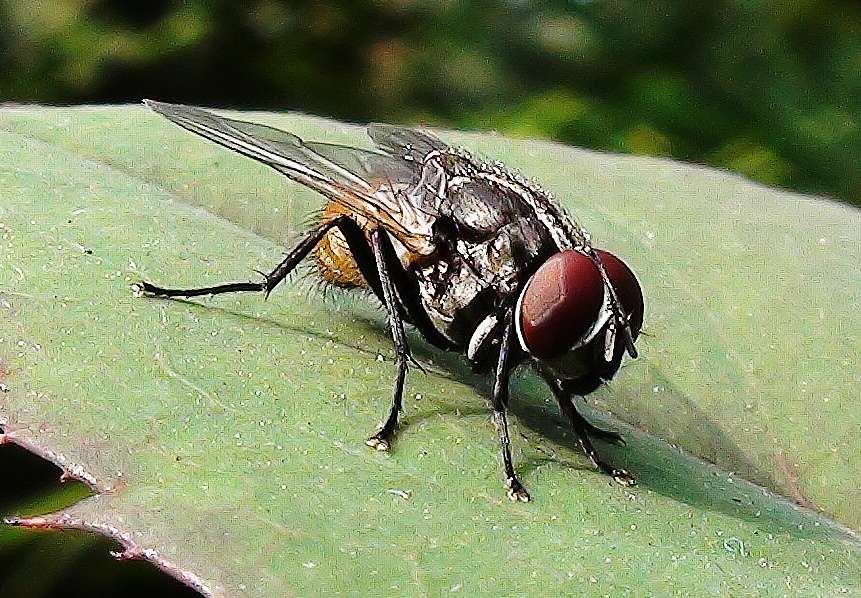SCORES & OUTDOORS: First sighting of the common house fly

 by Roland D. Hallee
by Roland D. Hallee
Another sign of spring is upon us.
While out checking and emptying my maple sap buckets last Monday, I saw a common house fly on the side of the bucket. The first one of the season. A sure sign of spring, but also the beginning of their irritation.
The housefly is the most common fly species found in houses. The female housefly usually mates only once and stores the sperm for later use. She lays batches of about 100 eggs on decaying organic matter such as food waste, carrion, or feces. These soon hatch into legless white larvae, known as maggots. Adult flies normally live for two to four weeks, but can hibernate during the winter. The adults feed on a variety of liquid or semi-liquid substances, as well as solid materials which have been softened by their saliva. They can carry pathogens on their bodies and in their feces, contaminate food, and contribute to the transfer of food-borne illnesses, while, in numbers, they can be physically annoying. For these reasons, they are considered pests.
The housefly is probably the insect with the widest distribution in the world; it is largely associated with humans and has accompanied them around the globe. It is present in the Arctic, as well as in the tropics, where it is abundant. It is present in all populated parts of Europe, Asia, Africa, Australasia, and the Americas.
Houseflies play an important ecological role in breaking down and recycling organic matter. Adults are mainly carnivorous; their primary food is animal matter, carrion, and feces, but they also consume milk, sugary substances, and rotting fruit and vegetables. Solid foods are softened with saliva before being sucked up. They can be opportunistic blood feeders.
Adult houseflies are diurnal (active during the day) and rest at night. If inside a building after dark, they tend to congregate on ceilings, beams, and overhead wires, while out of doors, they crawl into foliage or long grass, or rest in shrubs and trees or on wires. In cooler climates, some houseflies hibernate in winter, choosing to do so in cracks and crevices, gaps in woodwork, and the folds of curtains. They arouse in the spring when the weather warms up, and search out a place to lay their eggs.
Houseflies have many predators, including birds, reptiles, amphibians, various insects, and spiders.
Houseflies are a nuisance, disturbing people while at leisure and at work, but they are disliked principally because of their habits of contaminating foodstuffs. They alternate between breeding and feeding in dirty places while feeding on human foods, during which process they soften the food with saliva and deposit their feces, creating a health hazard. However, housefly larvae are as nutritious as fish meal, and could be used to convert waste to insect-based animal feed for farmed fish and livestock.
During the Second World War, the Japanese worked on entomological warfare techniques. Japanese Yagi bombs developed at Pingfan consisted of two compartments, one with houseflies and another with a bacterial slurry that coated the houseflies prior to release. Vibrio cholerae, which causes cholera, was the bacterium of choice, and was used in China in Baoshan in 1942, and in northern Shandong in 1943. Baoshan had been used by the Allies and bombing produced epidemics that killed 60,000 people in the initial stages. The Shandong attack killed 210,000; the occupying Japanese troops had been vaccinated in advance.
In literature, The Impertinent Insect is a group of five fables, sometimes ascribed to Aesop, concerning an insect, in one version a fly, which puffs itself up to seem important. In the Biblical fourth plague of Egypt, flies represent death and decay, while the Philistine god Beelzebub’s name may mean “lord of the flies”. In Greek mythology, Myiagros was a god who chased away flies during the sacrifices to Zeus and Athena; Zeus sent a fly to bite Pegasus, causing Bellerophon to fall back to Earth when he attempted to ride the winged steed to Mount Olympus. In the traditional Navajo religion, Big Fly is an important spirit being.
William Blake’s 1794 poem The Fly, part of his collection Songs of Experience, deals with the insect’s mortality, subject to uncontrollable circumstances, just like humans. Emily Dickinson’s 1855 poem I Heard a Fly Buzz When I Died speaks of flies in the context of death. In William Golding’s 1954 novel Lord of the Flies, the fly is, however, a symbol of the children involved.
Ogden Nash’s humorous two-line 1942 poem God in His wisdom made the fly/And then forgot to tell us why, indicates the debate about the value of biodiversity, given that even those considered by humans as pests have their place in the world’s ecosystems.
So, I guess the fly has its good and bad, mostly bad. I know one thing, when one enters the house, or camp, they can be annoying as all outdoors.
Roland’s trivia question of the week:
Who was the first player in MLB history to win the Most Valuable Player, Silver Slugger, Gold Glove, batting title, and World Series in the same season?
Responsible journalism is hard work!
It is also expensive!
If you enjoy reading The Town Line and the good news we bring you each week, would you consider a donation to help us continue the work we’re doing?
The Town Line is a 501(c)(3) nonprofit private foundation, and all donations are tax deductible under the Internal Revenue Service code.
To help, please visit our online donation page or mail a check payable to The Town Line, PO Box 89, South China, ME 04358. Your contribution is appreciated!


Leave a Reply
Want to join the discussion?Feel free to contribute!